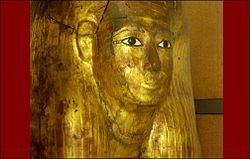Location Theban Tombs | Discovered 1906 | |
 | ||
Excavated by Arthur Weigall, Ernesto Schiaparelli Similar Museo Egizio, Deir el‑Medina, Tombs of the Nobles, Theban Necropolis, Temple of Ellesyia | ||
TT8 or Theban Tomb 8 was the site of one of the greatest archaeological discoveries in ancient Egypt. This New Kingdom era tomb was one of the few tombs of Ancient Egypt's nobility to have survived intact down through the centuries - it was only discovered by Arthur Weigall and Ernesto Schiaparelli in 1906 on behalf of the Italian Archaeological Mission. Its discoverers used 250 workers to dig in pursuit of the tomb for several weeks. The pyramid-chapel of Kha and his wife Merit had already been well known for many years; indeed, scenes from it had already been copied by several Egyptologists including John Gardiner Wilkinson and Karl Lepsius in the 19th century. Egyptologists also knew that Kha was an important foreman at Deir El-Medina where he had been responsible for projects constructed during the reigns of 3 kings: Amenhotep II, Thutmose IV and Amenhotep III respectively. The pyramidion of the chapel had already been removed by an earlier visitor and was now in the Louvre Museum.
Contents
Therefore, it was a surprise to Schiaparelli that Kha and Merit's burial was located in the isolated cliffs surrounding the village and not in the immediate proximity of the chapel itself as was conventionally the case for other burials of Egyptian nobility. The tomb held the funerary equipment of Kha, the overseer of works from Deir el-Medina in the mid-18th dynasty and Merit.
Tomb objects
The items found in the tomb show that Kha and Merit were quite wealthy during their lifetime. Unlike the more chaotic burial of Tutankhamun, Kha's burial had been carefully planned out, the more important items had been covered by dust sheets, and the floor had been swept when the last person had left. The coffins of Kha and Merit had been buried in two nested coffins; Kha's mummy had been tightly wrapped with several items of jewelry included within the wrappings. The two anthropoid coffins of Kha are excellent examples of the wealth and technically brilliant workmanship of the arts during the reign of Amenhotep III. Kha's outer coffin "was covered with black bitumen, with the face, hands, alternate stripes of the wig, bands of inscriptions, and figures of funerary gods [all] in gilded gesso. Meanwhile, Kha's inner coffin was:
Included in one of Kha's coffins is one of the earliest examples of the Egyptian Book of the Dead. An X-ray of Kha's mummy shows that it was "adorned with a gold necklace and heavy earrings, one of the earliest examples yet found of men wearing earrings."
Kha's wife Merit was buried in a single outer coffin with one inner anthropoid coffin and a cartonnage mask. Her mummy was loosely wrapped with funerary jewellery. A tomb of this magnitude would have taken years to prepare, a process that Kha certainly oversaw during his lifetime. Unexpectedly predeceased by his wife Merit, Kha donated his own coffin to his wife. Since it was too big for Merit’s mummy, Kha was forced to pack linens, monogrammed for him, around her mummy. Merit's single coffin combines features of Kha's inner and outer coffins; "the lid is entirely gilded, but the box is covered with black bitumen, with only the figures and inscriptions gilded." Both Kha's and Merit's anthropoid coffins were themselves contained within Middle Kingdom style "rectangular outer coffins covered with black bitumen and having vaulted, gable-ended lids." Kha's own coffin was mounted on sledge runners, notes Ernesto Schiaparelli in his 1927 publication report of the discovery. Thus, Kha and Merit’s tomb was furnished with all the objects necessary in the afterlife. Ointments and kohl were regarded as a necessary part of hygiene and these precious materials were held in a variety of lidded alabaster, glass, and faience vessels. Egyptians protected themselves from the flies and from sunlight by wearing dark kohl under the eyes (depicted as a long cosmetic stripe on sculptures). Other objects in the tomb include sandels and jar vessels. The Tomb of Kha and Merit also contained more than 100 clothing garments alone for the couple to use in their afterlife.
Location of Kha's objects
All the funerary objects from Kha's tomb, except for two small articles, were subsequently transferred to the Egyptian museum in Turin. Tomb TT8 was found at almost the same time as KV55 and less than 2 years after KV46, the tomb of Yuya and Tjuyu, which had almost the same contents as TT8 and dated to only slightly later in the reign of Amenhotep III.
